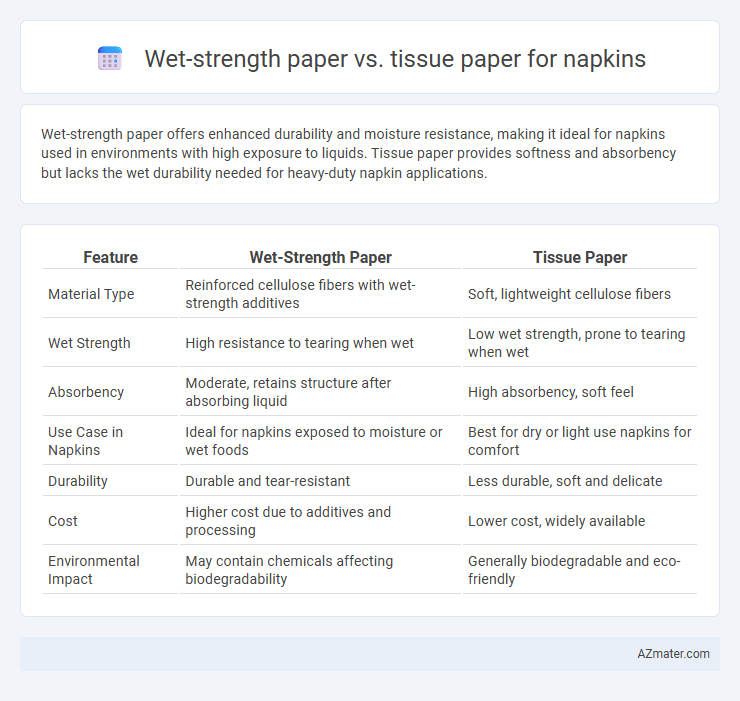Wet-strength paper offers enhanced durability and moisture resistance, making it ideal for napkins used in environments with high exposure to liquids. Tissue paper provides softness and absorbency but lacks the wet durability needed for heavy-duty napkin applications.
Table of Comparison
| Feature | Wet-Strength Paper | Tissue Paper |
|---|---|---|
| Material Type | Reinforced cellulose fibers with wet-strength additives | Soft, lightweight cellulose fibers |
| Wet Strength | High resistance to tearing when wet | Low wet strength, prone to tearing when wet |
| Absorbency | Moderate, retains structure after absorbing liquid | High absorbency, soft feel |
| Use Case in Napkins | Ideal for napkins exposed to moisture or wet foods | Best for dry or light use napkins for comfort |
| Durability | Durable and tear-resistant | Less durable, soft and delicate |
| Cost | Higher cost due to additives and processing | Lower cost, widely available |
| Environmental Impact | May contain chemicals affecting biodegradability | Generally biodegradable and eco-friendly |
Understanding Wet-Strength Paper: Key Characteristics
Wet-strength paper exhibits enhanced durability and moisture resistance due to chemical additives like polyamide-epichlorohydrin resin, making it ideal for napkins exposed to liquids. Unlike tissue paper, which is soft and highly absorbent but prone to disintegration when wet, wet-strength paper maintains structural integrity even when saturated. This key characteristic ensures napkins made from wet-strength paper provide reliable performance in demanding environments such as restaurants and food service.
What Is Tissue Paper? Features and Uses
Tissue paper is a lightweight, porous paper known for its softness, absorbency, and flexibility, commonly used in napkins, facial tissues, and wrapping materials. Its delicate texture and ability to absorb moisture make it ideal for gentle cleaning and personal care applications. Unlike wet-strength paper, which is engineered to maintain integrity when wet, tissue paper prioritizes comfort and disposability over durability.
Manufacturing Differences: Wet-Strength vs Tissue Paper
Wet-strength paper for napkins undergoes a chemical treatment during manufacturing that enhances its resistance to moisture, typically using additives like polyamide-epichlorohydrin (PAE) resins. Tissue paper, produced primarily from mechanically or chemically pulped fibers without these wet-strength additives, remains softer and more absorbent but lacks durability when wet. The manufacturing process of wet-strength paper involves a curing phase that cross-links fibers to retain strength in damp conditions, whereas tissue paper prioritizes softness and flexibility through gentle creping and embossing techniques.
Durability Comparison: How Each Performs When Wet
Wet-strength paper napkins maintain structural integrity and resist tearing when exposed to moisture, making them highly durable for use in damp or greasy conditions. Tissue paper napkins, while soft and absorbent, tend to weaken and tear easily when wet due to their low fiber bonding strength. The superior wet durability of wet-strength paper ensures reliable performance in napkin applications requiring moisture resistance.
Absorbency: Which Napkin Material Is Superior?
Wet-strength paper napkins contain resin additives that enhance durability and maintain structural integrity when wet, providing moderate absorbency suitable for heavy-duty use. Tissue paper napkins, made from softer, more porous fibers, offer superior absorbency by quickly soaking up liquids but tend to disintegrate under excessive moisture. For napkins prioritizing absorbency, tissue paper outperforms wet-strength paper due to its higher liquid retention capacity, although it sacrifices wet durability.
Cost Analysis: Wet-Strength Paper vs Tissue Paper
Wet-strength paper generally incurs higher production costs due to the incorporation of chemical additives that enhance durability and moisture resistance, making it more expensive compared to tissue paper. Tissue paper, primarily composed of softer fibers and lower-strength additives, offers a cost-effective option for disposable napkins with moderate absorbency requirements. When evaluating cost analysis, businesses must balance the elevated expense of wet-strength paper against its superior performance in wet environments, while tissue paper remains preferable for budget-conscious, low-moisture applications.
Environmental Impact and Biodegradability
Wet-strength paper for napkins contains synthetic resins that enhance durability but reduce biodegradability, leading to longer decomposition times and potential environmental harm. Tissue paper, made from natural fibers without chemical additives, offers superior biodegradability and a lower environmental footprint due to faster breakdown in composting and soil environments. Choosing tissue paper napkins supports sustainable waste management and decreases microplastic pollution compared to wet-strength paper options.
Aesthetic and Texture: Customer Experience
Wet-strength paper napkins offer a firmer, more durable texture that resists tearing and maintains shape when damp, providing a premium tactile experience valued in upscale dining. Tissue paper napkins feature a softer, lightweight texture that enhances comfort and absorbency, appealing to customers seeking gentle touch and disposability. The aesthetic of wet-strength napkins is often more refined with smooth finishes and crisp folds, while tissue paper napkins present a delicate, airy appearance, both influencing customer perception of quality and cleanliness.
Common Applications for Napkins: Pros and Cons
Wet-strength paper napkins excel in durability and moisture resistance, making them ideal for restaurant and catering services where spills are frequent, but they can feel stiffer and less biodegradable. Tissue paper napkins offer softness and high absorbency, preferred for everyday use in homes and events, though they lack durability when wet and may tear easily. Choosing between them depends on balancing the need for strength and reusability against comfort and environmental impact.
Choosing the Right Napkin Material for Your Needs
Wet-strength paper napkins offer enhanced durability and moisture resistance, making them ideal for use in settings with heavy spills or outdoor events where wet conditions are common. Tissue paper napkins, on the other hand, provide softness and absorbency suited for everyday dining and casual gatherings where comfort is a priority. Selecting the right napkin material depends on balancing the need for strength and wet durability versus softness and absorbency based on the specific usage environment.

Infographic: Wet-strength paper vs Tissue paper for Napkin
 azmater.com
azmater.com